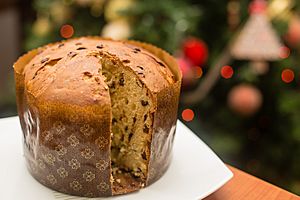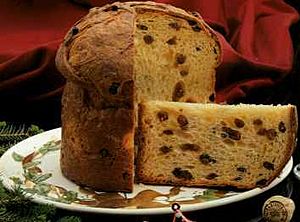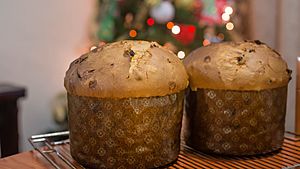Panettone facts for kids
 |
|
| Type | Yeast cake |
|---|---|
| Place of origin | Italy |
| Region or state | Milan |
| Main ingredients | Flour, candied fruits, raisins |
Panettone is a special sweet bread from Milan, Italy. People usually enjoy it during Christmas and New Year. It is popular in many parts of the world, including Europe, South America, Australia, and North America.
This cake has a unique shape, like a dome on top of a round base. It is usually about 12 to 15 centimeters tall. Making panettone takes a long time. The dough is similar to sourdough, which means it uses a special starter. This makes the cake light and fluffy.
Panettone often has candied orange, citron, and lemon peel inside. It also contains raisins. You can find other kinds too, like plain or with chocolate. People usually serve it in slices with a sweet drink or a sweet wine. In some parts of Italy, it is served with crema al mascarpone. This is a creamy sauce made from eggs, mascarpone cheese, and a sweet liqueur.
Some people are trying to get special protection for panettone. This would make sure that only panettone made in a certain way can use the name. This helps protect real Italian cakes from others.
Where Did Panettone Come From?
Panettone started in Milan, Italy. The name panettone comes from panetto, which means "small loaf." Adding -one makes it mean "large cake."
This sweet bread might have roots in ancient times. The Romans used to sweeten a type of leavened cake with honey.
The first clear mention of panettone was in 1599. A college in Pavia bought ingredients to make 13 "loaves" for students at Christmas. Later, in the 1700s, an Italian writer named Pietro Verri called it pan de ton. This means 'luxury bread'. This shows it was already a special Christmas treat.
Panettone in the 20th Century
In the early 1900s, two bakers in Milan started making panettone for everyone. In 1919, Angelo Motta began his own brand. He changed the traditional panettone. He made the dough rise three times, for almost 20 hours. This gave it its tall, domed shape and light texture.
Another baker, Gioacchino Alemagna, copied Motta's idea around 1925. Both bakers became very popular. Their competition led to panettone being made in factories. This made it available to many more people. Later, big companies like Nestlé and Bauli bought these brands.
After World War II, panettone became affordable for everyone. It quickly became the most popular Christmas sweet in Italy. Many Italian people moved to countries like Argentina, Brazil, and other parts of South America. They brought their love for panettone with them. Now, panettone is a big part of Christmas celebrations in those countries too. People often enjoy it with hot cocoa.
Panettone is very popular in South America. In Peru, a baker named Antonio D'Onofrio created his own version. He used local fruits like papaya instead of citron and lemon. This brand is also owned by Nestlé and sold across South America. Panettone is also popular in Italian communities in the U.S., Canada, Australia, and the UK.
Italian companies make millions of panettone cakes every Christmas. There is even an event in Milan that gives an award for the best traditional panettone in Italy.
See also
 In Spanish: Panetone para niños
In Spanish: Panetone para niños



